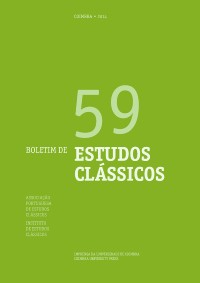Please use this identifier to cite or link to this item:
https://hdl.handle.net/10316.2/37524| DC Field | Value | Language |
|---|---|---|
| dc.contributor.author | Encarnação, José d’ | - |
| dc.date.accessioned | 2015-10-20T10:11:10Z | |
| dc.date.accessioned | 2020-09-21T05:30:46Z | - |
| dc.date.available | 2015-10-20T10:11:10Z | |
| dc.date.available | 2020-09-21T05:30:46Z | - |
| dc.date.issued | 2014 | - |
| dc.identifier.issn | 0872-2110 | - |
| dc.identifier.uri | https://hdl.handle.net/10316.2/37524 | - |
| dc.description.abstract | Procura mostrar‑se, através da análise da actividade dos sêxviros, como a religião e o poder se encontram intimamente ligados durante a época romana. Assinala‑se que eram predominantemente os libertos que integravam este colégio sacerdotal relacionado com o culto ao imperador. Exemplifica‑se com uma epígrafe de Balsa (IRCP 73), em que um sêxviro agradece à deusa Fortuna Augusta o ter sido eleito, atestando que cumpriu assim as promessas eleitorais. | por |
| dc.description.abstract | By examining the seviri’s activities present in the Roman epigraphic monuments, we seek to show how religion and the political power were closely connected during that time. Freedmen are the members of this college related to the worship of the emperor an epigraphic evidence (IRCP 73) of Balsa, a civitas in the south of Lusitania, shows us how a sevir thanks the goddess Fortuna Augusta for his election, with the promised organisation of pleasing events. | eng |
| dc.language.iso | por | - |
| dc.publisher | Imprensa da Universidade de Coimbra | - |
| dc.rights | open access | - |
| dc.subject | seviri | eng |
| dc.subject | augustales | eng |
| dc.subject | religion and political power | eng |
| dc.subject | seviri | por |
| dc.subject | augustales | por |
| dc.subject | religião e poder político | por |
| dc.title | A epígrafe latina como elemento didático (XXXIII): o colégio dos sêxviros: religião e poder em evidência | por |
| dc.title.alternative | The latin epigraphy as a didactic element (XXXIII): the college of seviri: religion and power in evidence | por |
| dc.type | article | - |
| uc.publication.collection | Boletim de Estudos Clássicos vol. 59 | - |
| uc.publication.firstPage | 95 | - |
| uc.publication.lastPage | 102 | - |
| uc.publication.location | Coimbra | - |
| uc.publication.journalTitle | Boletim de Estudos Clássicos | - |
| uc.publication.volume | 59 | por |
| dc.identifier.doi | 10.14195/0872-2110_59_7 | - |
| uc.publication.section | Latim | - |
| uc.publication.orderno | 9 | - |
| uc.publication.area | Artes e Humanidades | - |
| uc.publication.manifest | https://dl.uc.pt/json/iiif/10316.2/37524/229041/manifest?manifest=/json/iiif/10316.2/37524/229041/manifest | - |
| uc.publication.thumbnail | https://dl.uc.pt/retrieve/11435546 | - |
| item.grantfulltext | open | - |
| item.fulltext | With Fulltext | - |
| Appears in Collections: | Boletim de Estudos Clássicos | |
Files in This Item:
| File | Description | Size | Format | |
|---|---|---|---|---|
| a_epigrafe_latina_como_elemento_didactivo.pdf | 469.83 kB | Adobe PDF |  |
Items in DSpace are protected by copyright, with all rights reserved, unless otherwise indicated.
